
“See Nothing,” monoprint on paper by Roger Morris, “Bird of Prey” video by Sanne Maes, “Outer mantel 3” + “Outer mantel 4” (and each side of the open wall) by Yair Callender, “Trope” (in the third gallery beyond) by Raewyn Turner and ceramic sculpture by Jess Paraone, “Tomorrow will never be the same” interactive projection by Jian Yiwei and Sonja van Kerkhoff,
2 video loops by Pieterje van Splunter.

“Vaat” (Washing Up) 2014, stop motion animation, 7 minutes, 11 seconds, and “Cleaning the Air,” 2014, video, 43 seconds by Pieterje van Splunter, The Hague.
“Cleaning the Air” is a film of a sculpture by Pietertje which rotated diverse household items.
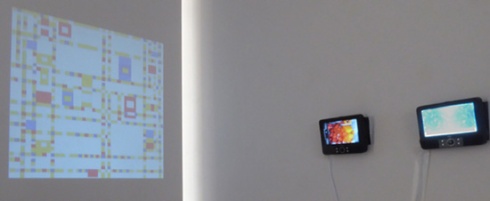
“Tomorrow will never be the same” interactive work by Jian Yiwei and Sonja van Kerkhoff, 2 video loops by Pieterje van Splunter.
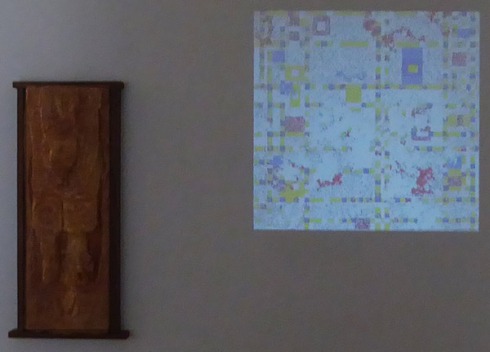
“Outer Mantel 4” by Yair Callender, “Tomorrow will never be the same” interactive work by Jian Yiwei and Sonja van Kerkhoff
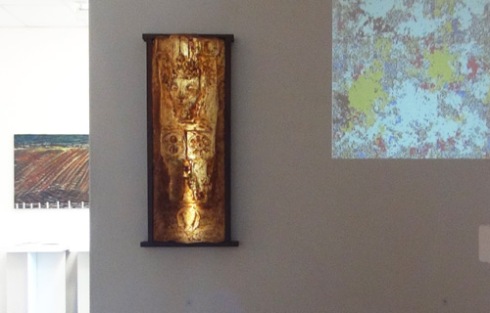
Detail of “Trope” (in the third gallery beyond) by Raewyn Turner and ceramic sculpture by Jess Paraone, “Outer Mantel 4” by Yair Callender, “Tomorrow will never be the same” interactive work by Jian Yiwei and Sonja van Kerkhoff
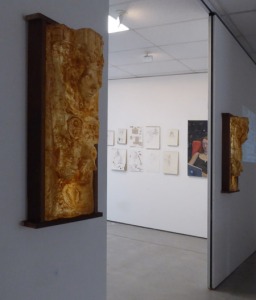
“Outer mantel 3 + 4” (on each side of the open wall), Layers of latex, LED lighting + recycled NZ pine, by Yair Callender. The wooden support was built to instructions given by Yair which included reusing old wood. Detail in the back gallery of drawings by Marianne Muggeridge.
Yair Callender, born in Groningen (1987) to a Dutch mother and a father who came from Suriname (South America) to the Netherlands to study in the early 1970s, is a graduate of the Hague Royal College of Arts (2014).
He works in concrete, plaster, clay and wood and his main focus is on making public sculpture.
Often his sculpture has some performative social element that involves the local community.
His major themes are cultural expressions and art in society in relation to playing with the idea of beauty in the ugly. The two larger pieces, layers of resin which are back-lit, were made for this exhibition.
These four pieces are playful interpretations of diverse religious symbols (Catholic gargoyles, Asian temples, the Kabbalah tree, etc) found on the exterior of buildings. He has made skins which are lit from within as a metaphor for our human condition – the beautiful seen through the rough and raw. Who could say art is ever ugly?

“Bird of Prey” video by Sanne Maes, latex light boxes by Yair Callender
Back gallery: “Your Honour” + “Eva was hier” (Eve was here) by Sonja van Kerkhoff, “Pandora’s Box” suspended panels by Alexis Hunter.

Detail: “Bird of Prey” video by Sanne Maes, latex light boxes by Yair Callender. Two videos by Pieterje van Splunter
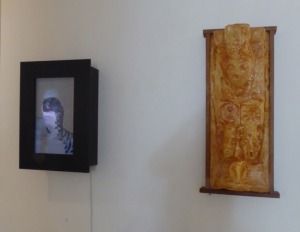
“Bird of Prey” video, HD, loop 0’25” photocopy on transparent paper. 21″ LCD tv inside custom-made frame, 61 x 40, Edition of 3. “Outer mantel 3” latex, LED lighting + recycled NZ pine, by Yair Callender.
“Bird of Prey” by Sanne Maes is from the morphological studies which concentrate on aspects of the outward appearance of humans and animals. In these works distant species are blended and so create transformations of identity.
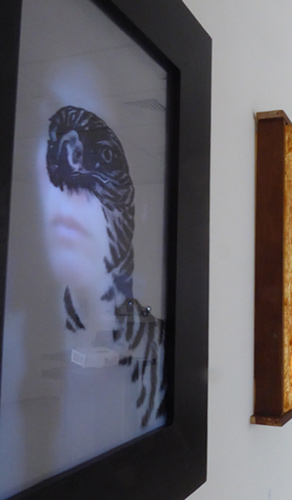
Detail: “Bird of Prey” video by Sanne Maes.
The woman slowly turns her head away and then when she looks ahead her eyes match that of the hawk.
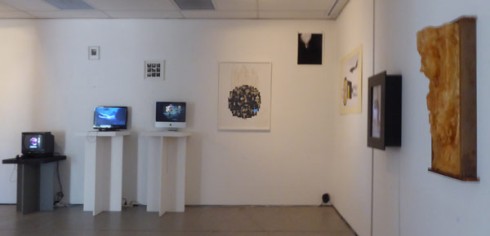
Videos by Channa Boon (The Hague), by Jonathan Reus + Sissel Marie Tonn (The Hague), and by Raewyn Turner and Brian Harris (Auckland). Four etchings by Virgina Guy (Hikurangi, Northland).
Side wall: Monoprint by Roger Morris (Taranaki), video by Sanne Maes (The Hague) and back lit latex relief by Yair Callender.
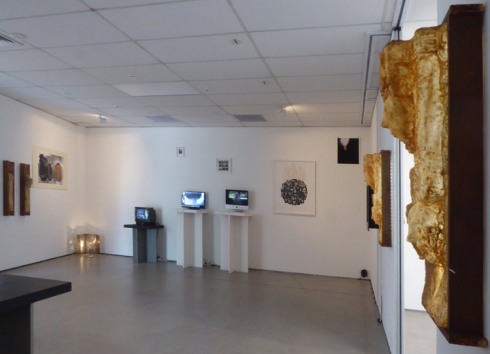
The latex boxes by Yair Callender on the left light up when approached. Monoprint by Roger Morris. Suspended sheet metal and lamp by Sonja van Kerkhoff. Videos by Channa Boon, by Jonathan Reus + Sissel Marie Tonn, and by Raewyn Turner and Brian Harris. Four etchings by Virgina Guy.

“Plastic Play,” video by Pietertje van Splunter
Middle Gallery: “Outer Mantel 1 + 2” responsive light latex light boxes by Yair Callender. “Road to JerUSAlem,” monoprint on paper by Roger Morris.
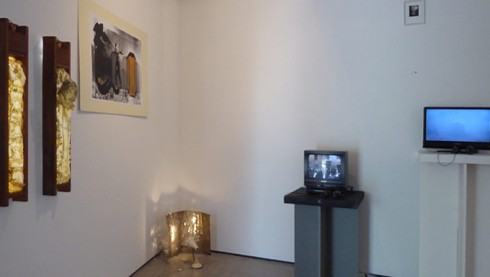
Responsive light latex light boxes by Yair Callender. Monoprint on paper by Roger Morris. “Fain would they put out God’s light,” cut out text sheet steel, nylon and lamp by Sonja van Kerkhoff. “Et in Arcadia ego” 29 min video by Channa Boon, “Sensory Cartographies,” 7 min video by Jonathan Reus + Sissel Marie Tonn. “Finding Flight,” photo intaglio with gold leaf by Virginia Guy.
The phrase ‘Et in Arcadia Ego’ is from a text by Virgil, and is the title of a famous painting (1638) by Nicolas Poussin. The phrase refers to the ideal world that Communism aimed to bring about in this region and the nostalgia that it still invokes.
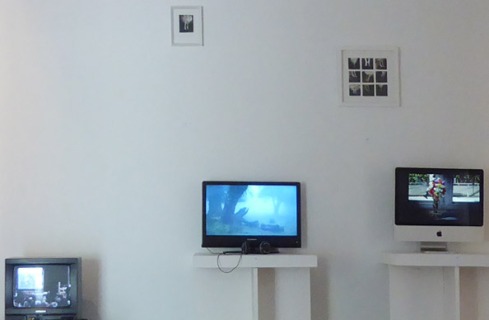
Above: two etchings by Virginia Guy. “Et in Arcadia ego” 29 min video by Channa Boon. “Sensory Cartographies,” 7 min video by Jonathan Reus + Sissel Marie Tonn. “Fallible,” 3 min video by Raewyn Turner and Brian Harris.
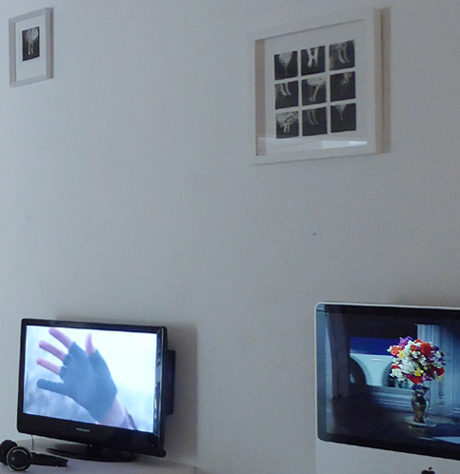
Above: “Finding Flight,” photo intaglio with gold leaf. Edition 1/1, 23 x 28 cm
“Finding Flight,” photo Intaglio with gold leaf. Edition 1/1, 33 x 33 cm by Virginia Guy.
“Sensory Cartographies,” 7 min video by Jonathan Reus + Sissel Marie Tonn.
“Fallible,” 3 min video by Raewyn Turner and Brian Harris. Unscented flowers rotate above a vase which holds a sensor and the data from the sensor is turned into piano notes.
More: raewynturner.com/projects
Raewyn Turner & Brian Harris combine art, engineering, science research and their skills developed over years of practice in theatre, the film industry, robotics, interactive software, video, olfactory, art installations and performances. They engage simple elements with engineering to create experiential art, utilising everyday objects reinterpreted with robotics, electronics and microprocessors.

Wall on right: “See Nothing,” monoprint on paper, 2017 by Roger Morris,
“Bird of Prey” video in custom frame by Sanne Maes.
Back wall: 4 etchings on paper by Virginia Guy.
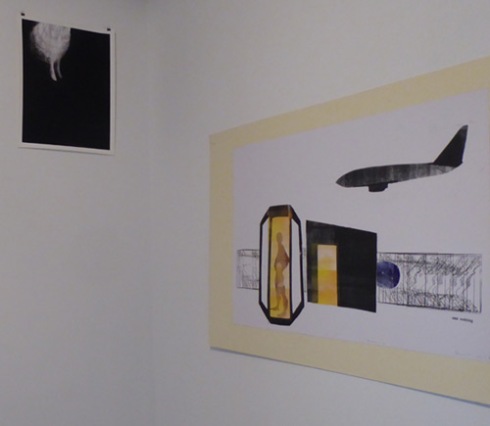
“Finding Flight,” photo intaglio on rag paper. Edition 1/10, 23 x 28 cm. “See Nothing,” monoprint on paper. 2017, by Roger Morris [R E M O].
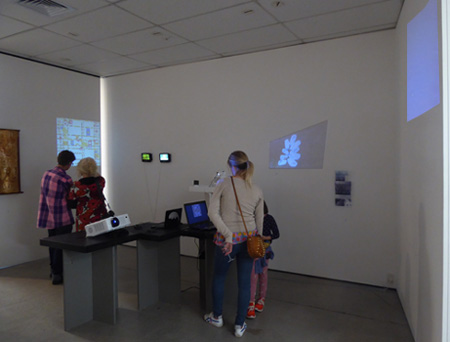
“Outer Mantle 3,” latex, LED lighting + recycled NZ pine, 2018, by Yair Callender. “Tomorrow will never be the same,” interactive projection by Jian Yiwei + Sonja van Kerkhoff. Two videos by Pietertje van Splunter. “A Meditation,” 7 min video loop by Sonja van Kerkhoff. “Several Seas,” laser print on transparency by Sonja van Kerkhoff. “The Experience of Change,” interactive projection by Jian Yiwei + Sonja van Kerkhoff.
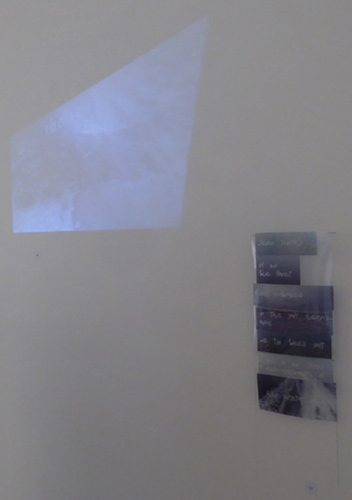
“Once our World had Edges” 2017, 3 min, 22 sec., HD video using only NASA International Space Station footage. Music: ‘a distant backdrop’ by sink \ sink, on the album ‘a lone cloudburst’ by Gareth Schott.
“Several Seas,” laser print, edition of 50, by Sonja van Kerkhoff.
Met dank aan Stroom Den Haag / with thanks to STROOM The Hague for finanicial assistance as well as to NorthArt.

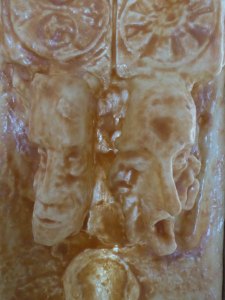
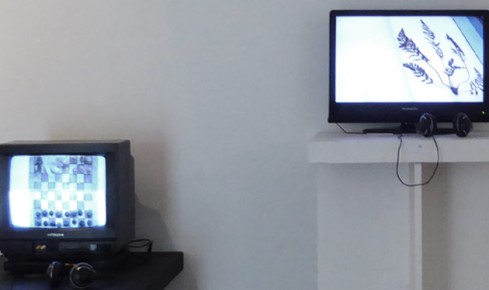
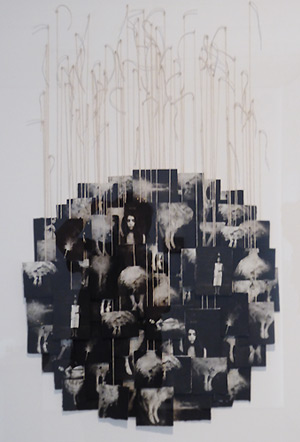
Leave a comment